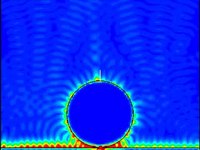
Photo from wikipedia
This article presents the multiple locally one-dimensional (MLOD) finite-difference time-domain (FDTD) method for multiconductor coupled transmission lines. The method is aptly referred to as the MLOD coupled line (CL)-FDTD method,… Click to show full abstract
This article presents the multiple locally one-dimensional (MLOD) finite-difference time-domain (FDTD) method for multiconductor coupled transmission lines. The method is aptly referred to as the MLOD coupled line (CL)-FDTD method, applicable for general asymmetrical multiconductor lines. The differential equations for multiconductor coupled transmission lines are expressed into general compact matrix form and the appropriate set of split matrices are proposed. Utilizing the proposed split matrices, the update procedures and equations of the MLOD CL-FDTD method are provided for general multiconductor lines. The update procedures comprise number of substeps depending on the number of conductor lines while the left-hand side of the implicit update equation constitutes a tridiagonal matrix that can be solved efficiently. The stability analysis is performed using the von Neumann method in the Fourier domain, as well as the two-media reduced-matrix method in the spatial domain for inhomogeneous media. It is found that our proposed method remains stable beyond the Courant time step. Numerical examples demonstrate that the MLOD CL-FDTD method is able to efficiently simulate time domain fields of multiconductor coupled transmission lines at time step larger than the Courant stability limit while maintaining good accuracy.
Journal Title: IEEE Journal on Multiscale and Multiphysics Computational Techniques
Year Published: 2020
Link to full text (if available)
Share on Social Media: Sign Up to like & get
recommendations!